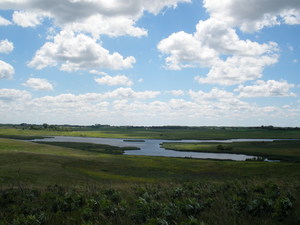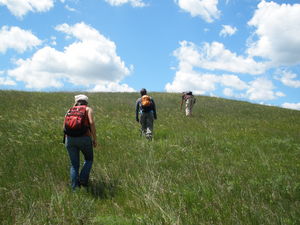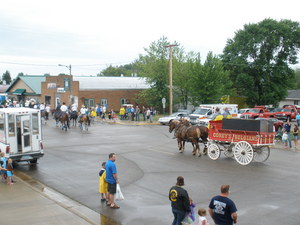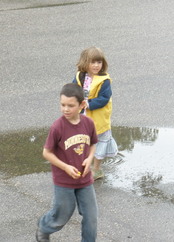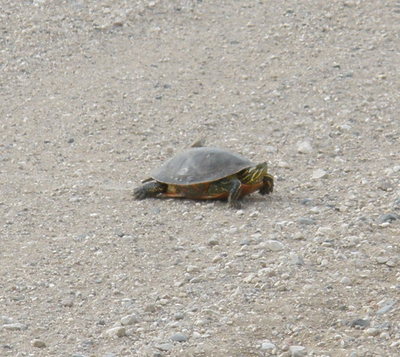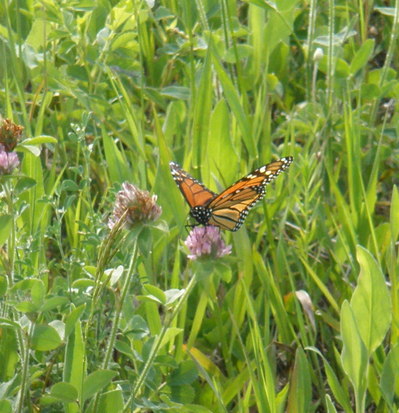|
|
Firstly, does anyone have a good acronym for this experiment? I tried PONS but don’t really like it.
Also, I wrote up a list of what each person needs for next week’s endeavors. If I’ve estimated times correctly, we need 9 people to do pollinator observations, 3-4 ppl for FNC (but the more the merrier), and 3-4 people for flagging plants beforehand (again the more the better) :ech PONS equip list.doc
What we still need :
>Ice packs (9)
>lunchbox coolers (6) I found 3 total but maybe there are more roaming around?
>stopwatch (1)–Greg offered to bring a couple back from his school for next week.Thanks Candyman!
9 possible remnants have been chosen (based on size of flowering plant populations in 2004 & 2005) and the back ups as well so here they are:
Staffanson, Landfill, North of Railroad crossing, LCW, NW Landfill, Riley, Yellow Orchid Hill, Steven’s approach, Nessman. Back ups: East Riley, EELR?, Railrd crossing
Hopefully Friday pm or Monday pm we can drive around to these sites and assess the abundance of flowering Echinacea plants, and also get a good understanding of what may be co-flowering with Echinacea next week. We will need to be flexible…if there aren’t enough plants flowering, then we will have to push the experiment back, and our second round later in the summer will have to be less than 2 weeks apart from the 1st round as we had originally planned.
A recent addition to our project is the potential to assess reproductive success using the style persistence method since it will be very valuable data and we are going to be collecting styles anyway for Kate.
We need to finalize protocols (I will try to post mine asap), figure out how to randomly select fl. plants in Staffanson and Landfill, the largest remnants, and I need to do some more practice runs of FNC with the newly made forms that Gretel helped me with today. We also will hopefully be able to do some practice runs of insect collecting this Friday with beemaster Amanda. I think field season is starting to get into full swing.
Thank you to everyone who has helped thus far with suggestions and advice. It has truly been appreciated.
In an attempt to outflog the rest of the team, I will describe what we did today. In the morning, most of us collected data for the phenology exp. No new plants had flowered, but some mistakes were caught in the flagging of positions from yesterday. I saw one of the large Halictid bees going to town on one of the flowering heads.Then until about 1, most of us headed out to the landfill site with different tasks in mind. I needed to do a test run of the FNC (I get tired of writing out floral neighborhood characterization) to see what obstacles we are going to face and about how long each one will take. Amanda helped me ID plants and test out the general protocol and it took about five minutes but there only 4 co-flowering species–Amorpha canascens, toothed evening primrose, Phlox pilosa, and Northern Bedstraw. Some species are more difficult to quantify in terms of number, such as Galium. After some discussion with Stuart, I think we will probably count each inflorescence as 1 “unit” so that counting the number of co-flowering species will be systematic and consistent. And now for more pretty pictures: 

Above: Glacial Lakes State Park trip, only a half hr away!

A plant we couldn’t ID. Help?


Old Runestone Day Parade pics, Per & Hattie the candy gatherers
Here’s what I’ve come up with for the revisions to my original proposal as of Friday’s group discussion; it is not in full form yet but I wanted to flog what I have so far so that people could read it and correct any mistakes I’ve made, make suggestions, etc.
Thanks
jenkins echinacea proposal revised.doc
Oh and friday was a big day in the common garden because the first Echinacea plant (in the 99garden I believe) released its pollen. Tomorrow we will investigate to see if any more have followed suit. We also searched for spittle on Echinacea plants for an hour on friday to help Daniel know whether he has a sufficient sample size and found 22 with spittle on them in roughly half the garden.
And I like pretty pictures so here’s one for fun

-Mimi


Those are just 2 of the many cool encounters I had yesterday on my bike ride past Hegg Lake and through Runestone Park. I also saw: pelicans, an American egret, a hare, tons of red-winged blackbirds and many other birds I can’t yet identify, a wild turkey, a skink, and lots of interesting pollinators. I also saw some flowering Echinacea along the side of the road…I think Stuart probably knows about them (?) but I didn’t see any tags and there ones that had flowered last year as well.
I thought I’d also flog the decisions we’d made last week about chores. The tasks are:
>sweep daily: G3–Mimi, the front porch–Allegra, and inside–Gretel
>clean the table tops and put away chairs daily–Amanda
>organize the bins and flags in G3 daily–Daniel
>shake out the rugs once a week–Amanda
>clean the bathroom once a week–?
-Mimi
Here’s my proposal for my project. Read it. Savor it. Constructively criticize it.
jenkins echinacea proposal.doc
It’s still very helter-skelter at this point and in need of much fine-tuning, so any suggestions are greatly appreciated. Thanks!
Also, I’ll re-attach the docx files from my last post in doc format.
Echinacea Pollinators nesting2.doc
Protocol for Taking Pictures of Insect Specimens.doc
On a side note, yesterday was a really exciting day because I found my first seedling, we got two bikes at a garage sale for $25 each, and there were the Runestone Days fireworks in the evening. The party lasted long into the night in K-town, and I think I remember falling asleep to the sweet sounds of AC/DC You shook me all night long coming from the street dance. These folks know how to party. I’m looking forward to the kiddie parade tomorrow! Although Amanda and I were saddened to hear it wouldn’t be a kitty parade.
Hello everyone! My name is Mimi Jenkins and I’m an REU student with Chicago Botanic Gardens. I am from Pittsburgh, PA where I am a senior (one more semester!) at the University of Pittsburgh double majoring in Environmental studies and French lang/lit and a certificate in Global studies. This is my first real experience spending more than one day in the Midwest and I love it so far. The wetlands and prairies out here are gorgeous and I feel very lucky to be experiencing a new and exciting place and working with such an interesting group of people on such a worthwhile and fascinating project. I have never been on such a flat land or in such a small town, but the flat topography makes for nice biking (hoping I can get my hands on a bike soon!) and the small town is a nice break from the city for the summer. I arrived in Chicago two weeks ago and after an introductory week for the REU program doing lab work on soil samples and such (not my cup o’ tea), I met Stuart, took pictures with the help of Jake Friedman of some of the Echinacea pollinators and visitors that are pinned and in boxes at CBG, and did a little research on the nesting habits of bees.
Here is the protocol we came up with for the picture-taking:Protocol for Taking Pictures of Insect Specimens.docx
Here is some of the info I found on nesting of bees commonly found on Echinacea:
Echinacea Pollinators nesting.docx
I am really excited about this field season and I wish I could stay longer! I am really interested in improving my plant and bee identification skills on the prairie, as well as my knowledge of statistics in analyzing data and applied ecology in general. I also hope that this experience will help me to hone in on what I want to focus on for graduate schools in a year or two. I am currently trying to think about what exactly I would like to focus on because everything sounds so cool but I am limited to less than 6 weeks of research so it must be a pretty precise question, such as: does one family or species of bee act as a more effective pollinator for Echinacea than others using the style persistence method, or what co-flowering species are the pollinators pollinating that also land on Echinacea by observing pollinators on other plants or looking at foreign pollen on Echinacea heads. I would like to work in the common garden and in remnant populations to get a good sense of how these questions might differ depending on the community diversity of the remnant and the health of the Echinacea population.
I went out wandering yesterday and I think some of the locals thought I was a crazy person for walking on the side of the road but until I can bike, I will explore by foot. I turned onto the first dirt road on the right off of Kensington Ave and found this pretty hillside prairie remnant at the end of the road. I wanted to go further, but the electric fence kept me from continuing. I saw a patch of something yellow flowering off in the distance. Along the path of the dirt road between two corn fields I saw what I think was brome grass, prairie rose, common milkweed, alfalfa and clover, and some others like thistles that I couldn’t identify. I saw a big white bird that Stuart told me today was an American egret. I also saw some more of those cool turquoise dragonflies that are in the common garden. I regret not bringing my camera with me because the view at the end of the dirt road was so pretty–there were relatively few trees and you could gently rolling green hills for miles.
|
|

